Car Hyundai Santa Fe Sport 2016 Owner's Manual
[x] Cancel search | Manufacturer: HYUNDAI, Model Year: 2016, Model line: Santa Fe Sport, Model: Hyundai Santa Fe Sport 2016Pages: 763, PDF Size: 37.75 MB
Page 1 of 763
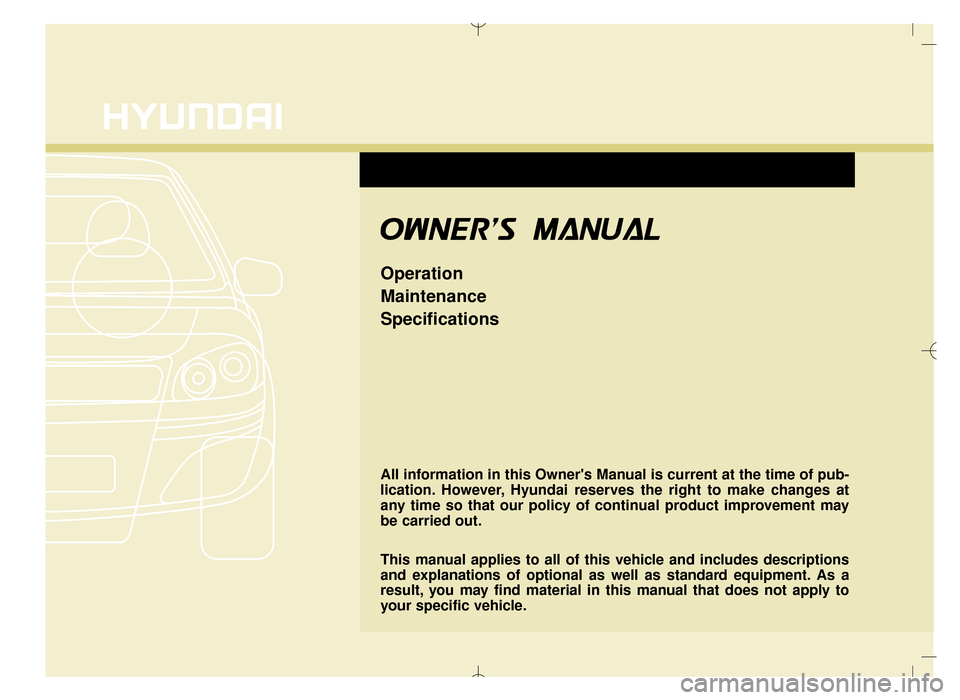
All information in this Owner's Manual is current at the time of pub-
lication. However, Hyundai reserves the right to make changes at
any time so that our policy of continual product improvement may
be carried out.
This manual applies to all of this vehicle and includes descriptions
and explanations of optional as well as standard equipment. As a
result, you may find material in this manual that does not apply to
your specific vehicle.
O
OW
W N
NE
ER
R '
'S
S M
M A
AN
N U
UA
A L
L
Operation
Maintenance
Specifications
AN HMA FOREWORD.QXP 2015-05-07 ¿ ¨˜ 4:12 Page 1
Page 2 of 763

F2Your Hyundai should not be modified in any way. Such modifications may adversely affect
the performance, safety or durability of your Hyundai and may, in addition, violate conditions
of the limited warranties covering the vehicle. Certain modifications may also be in violation
of regulations established by the U.S. Department of Transportation and other federal or
state agencies.
Your vehicle is equipped with electronic fuel injection and other electronic c\
omponents. It is
possible for an improperly installed/adjusted two-way radio or cellular telephone to adverse-
ly affect electronic systems. For this reason, we recommend that you carefully follow the
radio manufacturer's instructions or consult your Hyundai dealer for precautionary meas-
ures or special instructions if you choose to install one of these devices.
CAUTION: MODIFICATIONS TO YOUR HYUNDAI
TWO-WAY RADIO OR CELLULAR TELEPHONE INSTALLATION
AN HMA FOREWORD.QXP 2015-05-07 ¿ ¨˜ 4:12 Page 2
Page 4 of 763
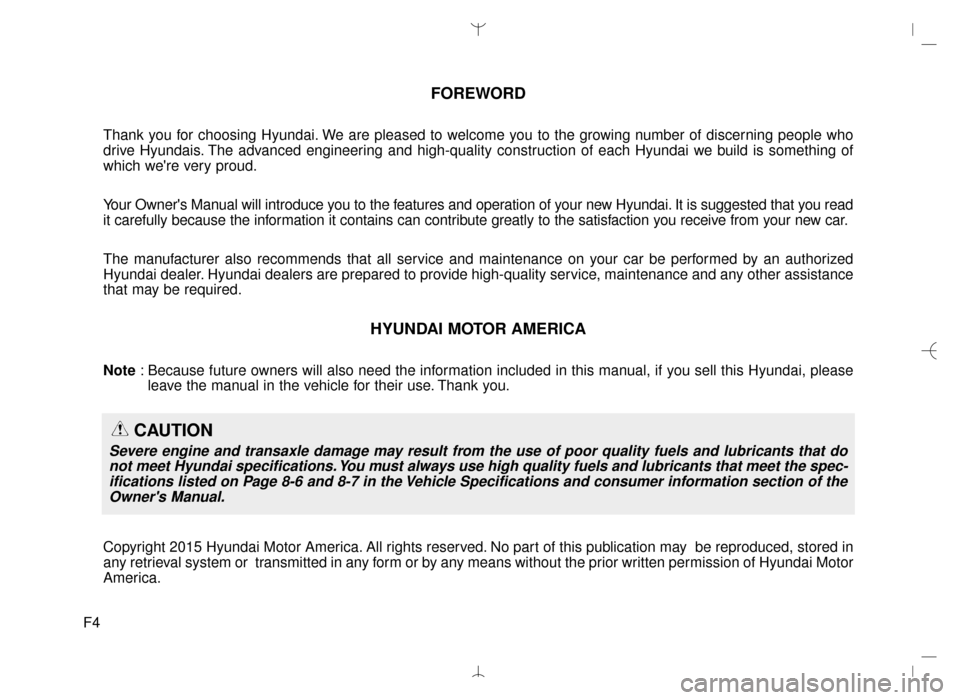
F4
FOREWORD
Thank you for choosing Hyundai. We are pleased to welcome you to the growing number of discerning people who
drive Hyundais. The advanced engineering and high-quality construction of each Hyundai we build is something of
which we're very proud.
Your Owner's Manual will introduce you to the features and operation of your new Hyundai. It is suggested that you read
it carefully because the information it contains can contribute greatly to the satisfaction you receive from your new car.
The manufacturer also recommends that all service and maintenance on your car be performed by an authorized
Hyundai dealer. Hyundai dealers are prepared to provide high-quality service, maintenance and any other assistance
that may be required.
HYUNDAI MOTOR AMERICA
Note: Because future owners will also need the information included in this manual, if you sell this Hyundai, please
leave the manual in the vehicle for their use. Thank you.
Copyright 2015 Hyundai Motor America. All rights reserved. No part of this publication may be reproduced, stored in
any retrieval system or transmitted in any form or by any means without the prior written permission of Hyundai Motor
America.
CAUTION
Severe engine and transaxle damage may result from the use of poor quality fuels and lubricants that do not meet Hyundai specifications. You must always use high quality fuels and lubricants that meet the spec-ifications listed on Page 8-6 and 8-7 in the Vehicle Specifications and consumer information section of theOwner's Manual.
AN HMA FOREWORD.QXP 2015-05-07 ¿ ¨˜ 4:12 Page 4
Page 9 of 763
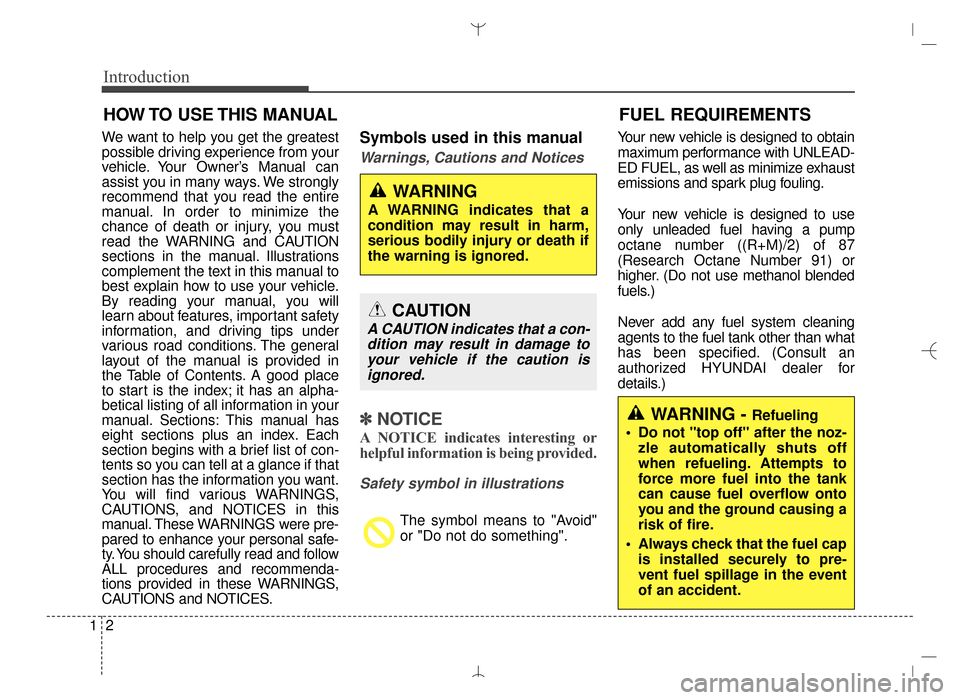
Introduction
21
We want to help you get the greatest
possible driving experience from your
vehicle. Your Owner’s Manual can
assist you in many ways. We strongly
recommend that you read the entire
manual. In order to minimize the
chance of death or injury, you must
read the WARNING and CAUTION
sections in the manual. Illustrations
complement the text in this manual to
best explain how to use your vehicle.
By reading your manual, you will
learn about features, important safety
information, and driving tips under
various road conditions. The general
layout of the manual is provided in
the Table of Contents. A good place
to start is the index; it has an alpha-
betical listing of all information in your
manual. Sections: This manual has
eight sections plus an index. Each
section begins with a brief list of con-
tents so you can tell at a glance if that
section has the information you want.
You will find various WARNINGS,
CAUTIONS, and NOTICES in this
manual. These WARNINGS were pre-
pared to enhance your personal safe-
ty. You should carefully read and follow
ALL procedures and recommenda-
tions provided in these WARNINGS,
CAUTIONS and NOTICES.Symbols used in this manual
Warnings, Cautions and Notices
✽ ✽NOTICE
A NOTICE indicates interesting or
helpful information is being provided.
Safety symbol in illustrations
The symbol means to "Avoid"
or "Do not do something". Your new vehicle is designed to obtain
maximum performance with UNLEAD-
ED FUEL, as well as minimize exhaust
emissions and spark plug fouling.
Your new vehicle is designed to use
only unleaded fuel having a pump
octane number ((R+M)/2) of 87
(Research Octane Number 91) or
higher. (Do not use methanol blended
fuels.)
Never add any fuel system cleaning
agents to the fuel tank other than what
has been specified. (Consult an
authorized HYUNDAI dealer for
details.)
HOW TO USE THIS MANUAL
WARNING
A WARNING indicates that a
condition may result in harm,
serious bodily injury or death if
the warning is ignored.
CAUTION
A CAUTION indicates that a con-
dition may result in damage toyour vehicle if the caution isignored.
FUEL REQUIREMENTS
WARNING - Refueling
• Do not "top off" after the noz- zle automatically shuts off
when refueling. Attempts to
force more fuel into the tank
can cause fuel overflow onto
you and the ground causing a
risk of fire.
Always check that the fuel cap is installed securely to pre-
vent fuel spillage in the event
of an accident.
AN HMA 1.QXP 2015-02-03 ¿ 11:07 Page 2
Page 11 of 763
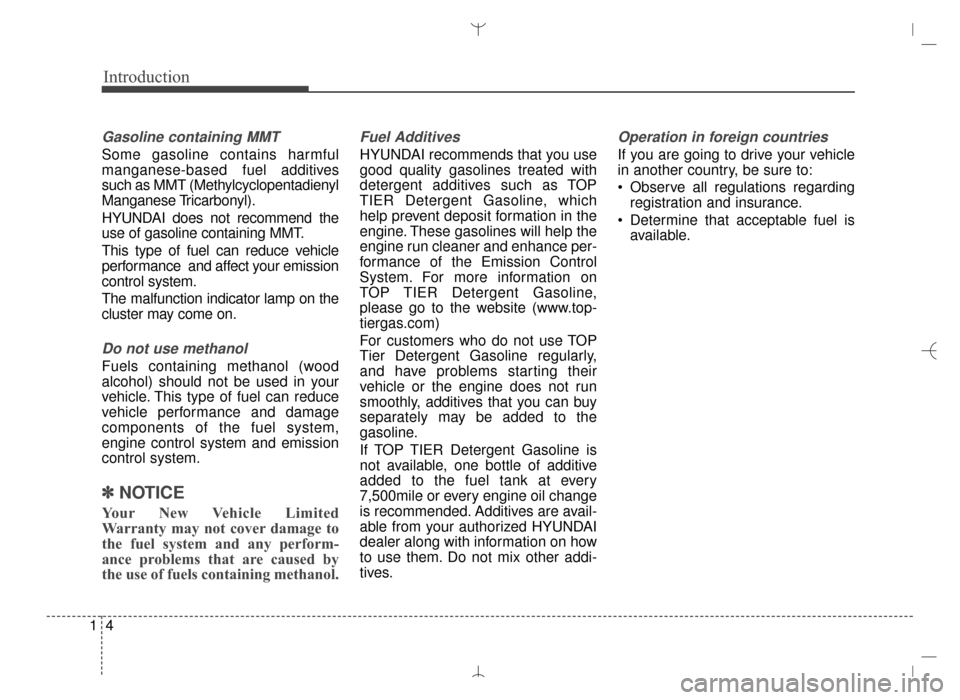
Introduction
41
Gasoline containing MMT
Some gasoline contains harmful
manganese-based fuel additives
such as MMT (Methylcyclopentadienyl
Manganese Tricarbonyl).
HYUNDAI does not recommend the
use of gasoline containing MMT.
This type of fuel can reduce vehicle
performance and affect your emission
control system.
The malfunction indicator lamp on the
cluster may come on.
Do not use methanol
Fuels containing methanol (wood
alcohol) should not be used in your
vehicle. This type of fuel can reduce
vehicle performance and damage
components of the fuel system,
engine control system and emission
control system.
✽ ✽ NOTICE
Your New Vehicle Limited
Warranty may not cover damage to
the fuel system and any perform-
ance problems that are caused by
the use of fuels containing methanol.
Fuel Additives
HYUNDAI recommends that you use
good quality gasolines treated with
detergent additives such as TOP
TIER Detergent Gasoline, which
help prevent deposit formation in the
engine. These gasolines will help the
engine run cleaner and enhance per-
formance of the Emission Control
System. For more information on
TOP TIER Detergent Gasoline,
please go to the website (www.top-
tiergas.com)
For customers who do not use TOP
Tier Detergent Gasoline regularly,
and have problems starting their
vehicle or the engine does not run
smoothly, additives that you can buy
separately may be added to the
gasoline.
If TOP TIER Detergent Gasoline is
not available, one bottle of additive
added to the fuel tank at every
7,500mile or every engine oil change
is recommended. Additives are avail-
able from your authorized HYUNDAI
dealer along with information on how
to use them. Do not mix other addi-
tives.
Operation in foreign countries
If you are going to drive your vehicle
in another country, be sure to:
Observe all regulations regarding
registration and insurance.
Determine that acceptable fuel is available.
AN HMA 1.QXP 2015-02-03 ¿ 11:07 Page 4
Page 22 of 763
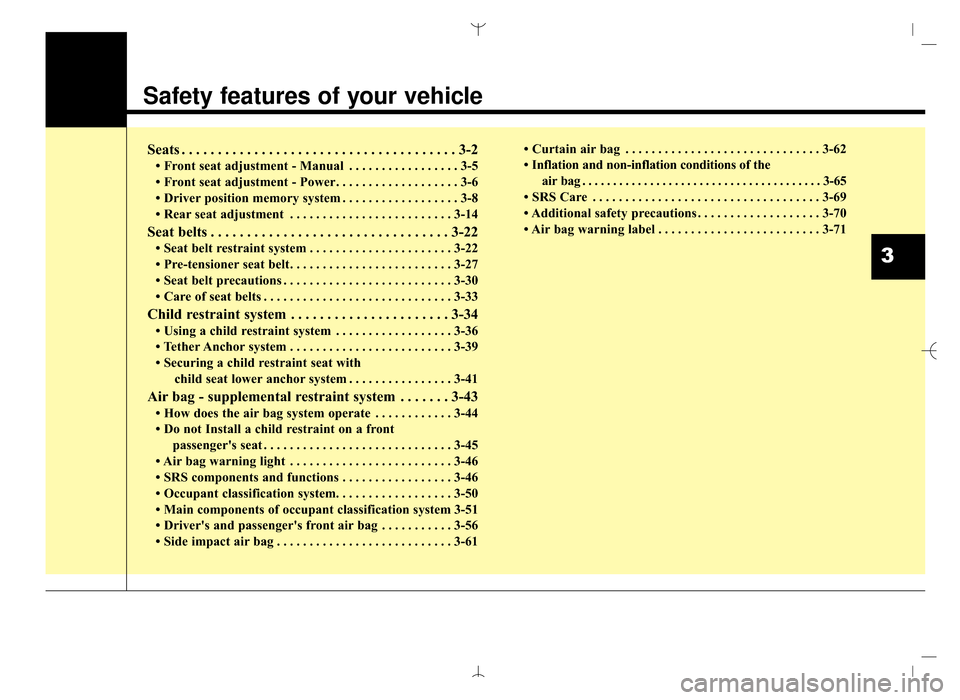
Safety features of your vehicle
Seats . . . . . . . . . . . . . . . . . . . . . . . . . . . . . . . . . . . . \
. . 3-2
• Front seat adjustment - Manual . . . . . . . . . . . . . . . . . 3-5
• Front seat adjustment - Power. . . . . . . . . . . . . . . . . . . 3-6
• Driver position memory system . . . . . . . . . . . . . . . . . . 3-8
• Rear seat adjustment . . . . . . . . . . . . . . . . . . . . . . . . . 3-14
Seat belts . . . . . . . . . . . . . . . . . . . . . . . . . . . . . . . . . 3-22
• Seat belt restraint system . . . . . . . . . . . . . . . . . . . . . . 3-22
• Pre-tensioner seat belt. . . . . . . . . . . . . . . . . . . . . . . . . 3-27
• Seat belt precautions . . . . . . . . . . . . . . . . . . . . . . . . . . 3-30
• Care of seat belts . . . . . . . . . . . . . . . . . . . . . . . . . . . . . 3-33
Child restraint system . . . . . . . . . . . . . . . . . . . . . . 3-34
• Using a child restraint system . . . . . . . . . . . . . . . . . . 3-36
• Tether Anchor system . . . . . . . . . . . . . . . . . . . . . . . . . 3-39
• Securing a child restraint seat with child seat lower anchor system . . . . . . . . . . . . . . . . 3-41
Air bag - supplemental restraint system . . . . . . . 3-43
• How does the air bag system operate . . . . . . . . . . . . 3-44
• Do not Install a child restraint on a front passenger's seat . . . . . . . . . . . . . . . . . . . . . . . . . . . . . 3-45
• Air bag warning light . . . . . . . . . . . . . . . . . . . . . . . . . 3-46
• SRS components and functions . . . . . . . . . . . . . . . . . 3-46
• Occupant classification system. . . . . . . . . . . . . . . . . . 3-50
• Main components of occupant classification system 3-51
• Driver's and passenger's front air bag . . . . . . . . . . . 3-56
• Side impact air bag . . . . . . . . . . . . . . . . . . . . . . . . . . . 3-61 • Curtain air bag . . . . . . . . . . . . . . . . . . . . . . . . . . . . . . 3-62
• Inflation and non-inflation conditions of the
air bag . . . . . . . . . . . . . . . . . . . . . . . . . . . . . . . . . . . . \
. . . 3-65
• SRS Care . . . . . . . . . . . . . . . . . . . . . . . . . . . . . . . . . . . 3-\
69
• Additional safety precautions . . . . . . . . . . . . . . . . . . . 3-70
• Air bag warning label . . . . . . . . . . . . . . . . . . . . . . . . . 3-71
3
AN HMA 3.QXP 3/5/2015 3:09 PM Page 1
Page 25 of 763
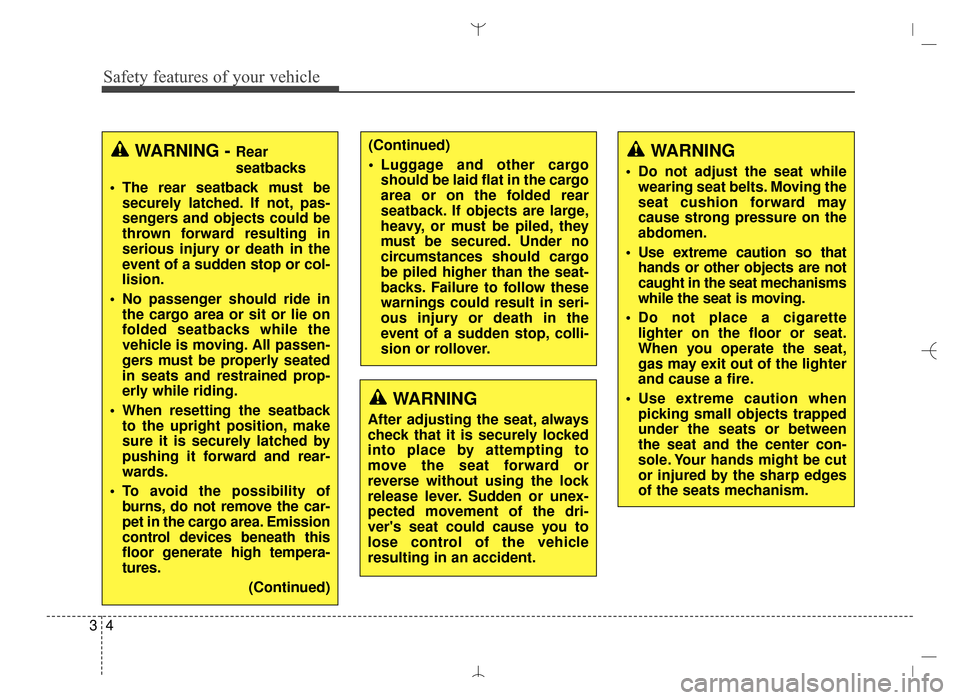
Safety features of your vehicle
43
WARNING - Rear
seatbacks
The rear seatback must be securely latched. If not, pas-
sengers and objects could be
thrown forward resulting in
serious injury or death in the
event of a sudden stop or col-
lision.
No passenger should ride in the cargo area or sit or lie on
folded seatbacks while the
vehicle is moving. All passen-
gers must be properly seated
in seats and restrained prop-
erly while riding.
When resetting the seatback to the upright position, make
sure it is securely latched by
pushing it forward and rear-
wards.
To avoid the possibility of burns, do not remove the car-
pet in the cargo area. Emission
control devices beneath this
floor generate high tempera-
tures.
(Continued)(Continued)
Luggage and other cargoshould be laid flat in the cargo
area or on the folded rear
seatback. If objects are large,
heavy, or must be piled, they
must be secured. Under no
circumstances should cargo
be piled higher than the seat-
backs. Failure to follow these
warnings could result in seri-
ous injury or death in the
event of a sudden stop, colli-
sion or rollover.
WARNING
After adjusting the seat, always
check that it is securely locked
into place by attempting to
move the seat forward or
reverse without using the lock
release lever. Sudden or unex-
pected movement of the dri-
ver's seat could cause you to
lose control of the vehicle
resulting in an accident.
WARNING
Do not adjust the seat whilewearing seat belts. Moving the
seat cushion forward may
cause strong pressure on the
abdomen.
Use extreme caution so that hands or other objects are not
caught in the seat mechanisms
while the seat is moving.
Do not place a cigarette lighter on the floor or seat.
When you operate the seat,
gas may exit out of the lighter
and cause a fire.
Use extreme caution when picking small objects trapped
under the seats or between
the seat and the center con-
sole. Your hands might be cut
or injured by the sharp edges
of the seats mechanism.
AN HMA 3.QXP 3/5/2015 3:09 PM Page 4
Page 26 of 763
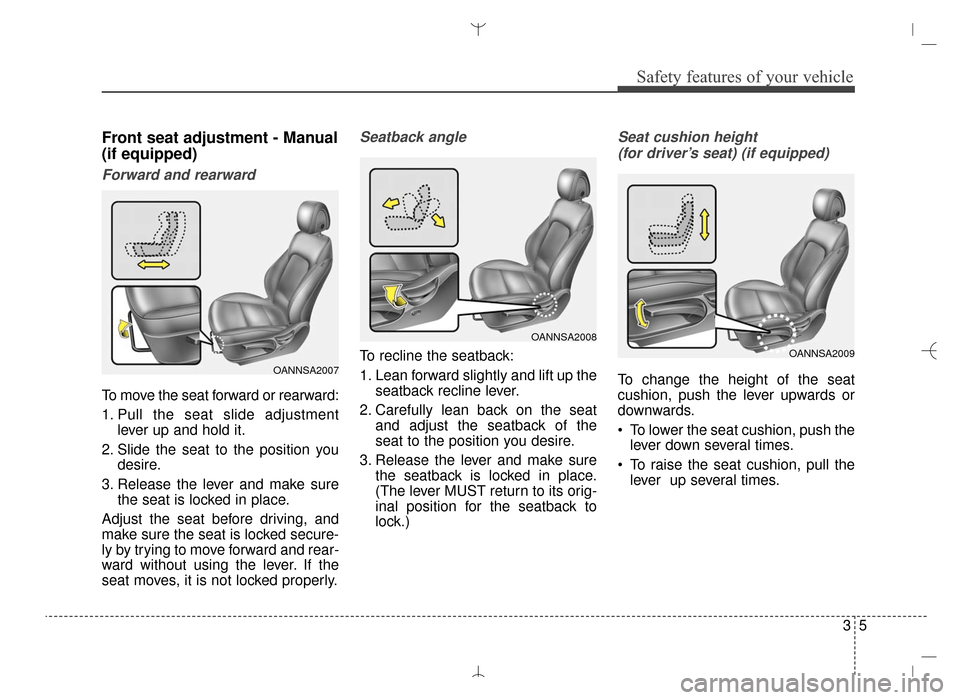
35
Safety features of your vehicle
Front seat adjustment - Manual
(if equipped)
Forward and rearward
To move the seat forward or rearward:
1. Pull the seat slide adjustmentlever up and hold it.
2. Slide the seat to the position you desire.
3. Release the lever and make sure the seat is locked in place.
Adjust the seat before driving, and
make sure the seat is locked secure-
ly by trying to move forward and rear-
ward without using the lever. If the
seat moves, it is not locked properly.
Seatback angle
To recline the seatback:
1. Lean forward slightly and lift up the seatback recline lever.
2. Carefully lean back on the seat and adjust the seatback of the
seat to the position you desire.
3. Release the lever and make sure the seatback is locked in place.
(The lever MUST return to its orig-
inal position for the seatback to
lock.)
Seat cushion height
(for driver’s seat) (if equipped)
To change the height of the seat
cushion, push the lever upwards or
downwards.
To lower the seat cushion, push the lever down several times.
To raise the seat cushion, pull the lever up several times.OANNSA2007
OANNSA2008
OANNSA2009
AN HMA 3.QXP 3/5/2015 3:09 PM Page 5
Page 33 of 763
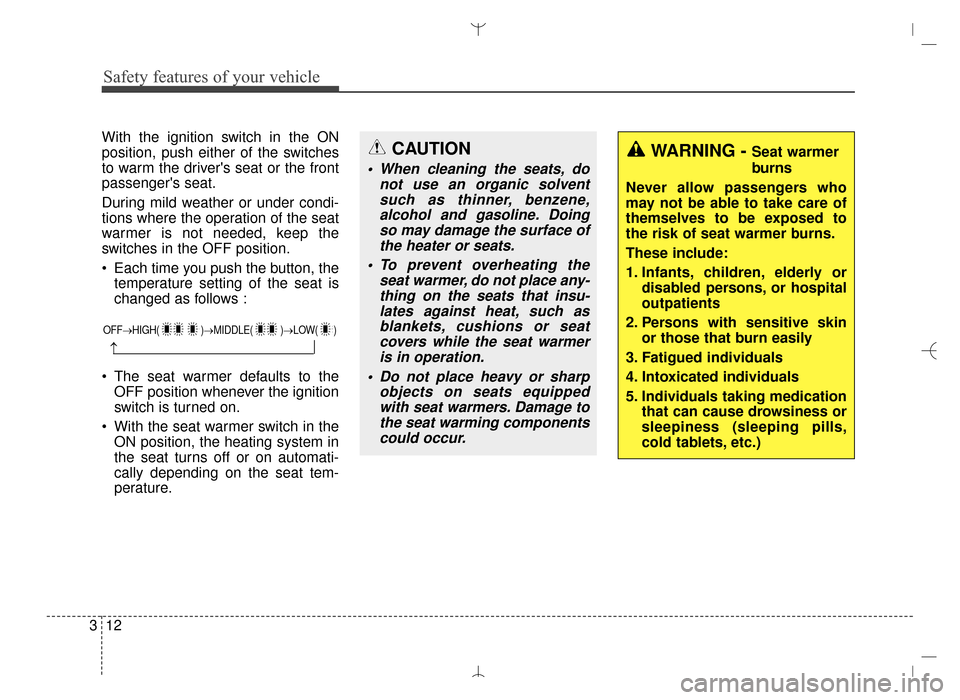
Safety features of your vehicle
12
3
With the ignition switch in the ON
position, push either of the switches
to warm the driver's seat or the front
passenger's seat.
During mild weather or under condi-
tions where the operation of the seat
warmer is not needed, keep the
switches in the OFF position.
Each time you push the button, the
temperature setting of the seat is
changed as follows :
The seat warmer defaults to the OFF position whenever the ignition
switch is turned on.
With the seat warmer switch in the ON position, the heating system in
the seat turns off or on automati-
cally depending on the seat tem-
perature.
WARNING - Seat warmer
burns
Never allow passengers who
may not be able to take care of
themselves to be exposed to
the risk of seat warmer burns.
These include:
1. Infants, children, elderly or disabled persons, or hospital
outpatients
2. Persons with sensitive skin or those that burn easily
3. Fatigued individuals
4. Intoxicated individuals
5. Individuals taking medication that can cause drowsiness or
sleepiness (sleeping pills,
cold tablets, etc.)CAUTION
When cleaning the seats, donot use an organic solventsuch as thinner, benzene,alcohol and gasoline. Doingso may damage the surface ofthe heater or seats.
To prevent overheating the seat warmer, do not place any-thing on the seats that insu-lates against heat, such asblankets, cushions or seatcovers while the seat warmeris in operation.
Do not place heavy or sharp objects on seats equippedwith seat warmers. Damage tothe seat warming componentscould occur.
OFF→ HIGH( )→ MIDDLE( )→LOW( )
→
AN HMA 3.QXP 3/5/2015 3:09 PM Page 12
Page 39 of 763
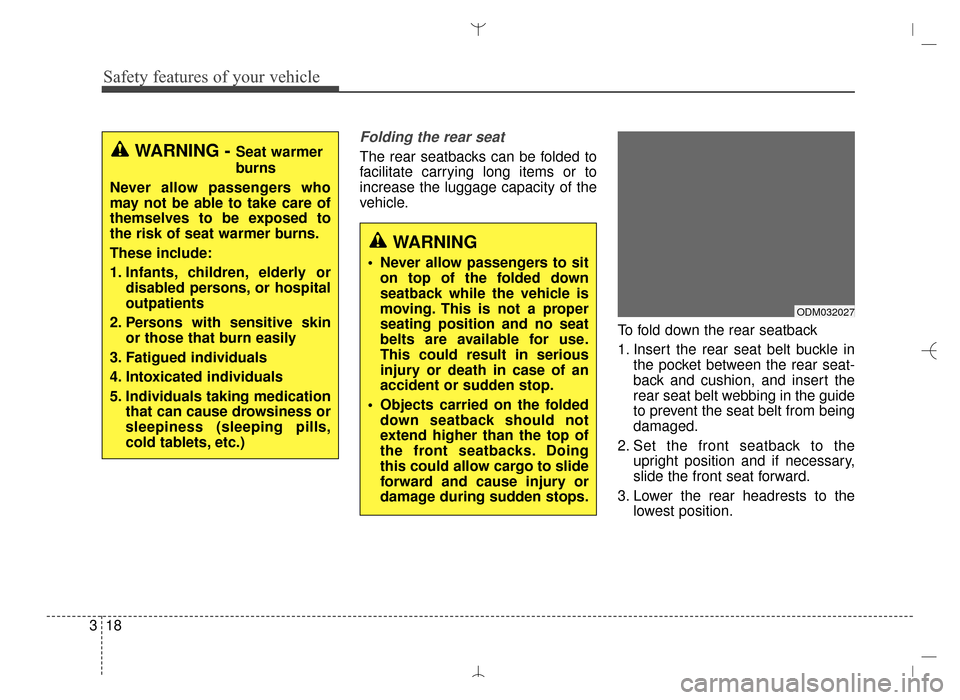
Safety features of your vehicle
18
3
Folding the rear seat
The rear seatbacks can be folded to
facilitate carrying long items or to
increase the luggage capacity of the
vehicle.
To fold down the rear seatback
1. Insert the rear seat belt buckle inthe pocket between the rear seat-
back and cushion, and insert the
rear seat belt webbing in the guide
to prevent the seat belt from being
damaged.
2. Set the front seatback to the upright position and if necessary,
slide the front seat forward.
3. Lower the rear headrests to the lowest position.WARNING - Seat warmer
burns
Never allow passengers who
may not be able to take care of
themselves to be exposed to
the risk of seat warmer burns.
These include:
1. Infants, children, elderly or disabled persons, or hospital
outpatients
2. Persons with sensitive skin or those that burn easily
3. Fatigued individuals
4. Intoxicated individuals
5. Individuals taking medication that can cause drowsiness or
sleepiness (sleeping pills,
cold tablets, etc.)
WARNING
Never allow passengers to siton top of the folded down
seatback while the vehicle is
moving. This is not a proper
seating position and no seat
belts are available for use.
This could result in serious
injury or death in case of an
accident or sudden stop.
Objects carried on the folded down seatback should not
extend higher than the top of
the front seatbacks. Doing
this could allow cargo to slide
forward and cause injury or
damage during sudden stops.
ODM032027
AN HMA 3.QXP 3/5/2015 3:09 PM Page 18